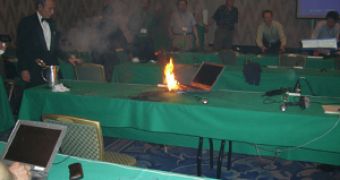The past few years seem to have been cursed for the laptop integrators. In summer 2006, Dell had to recall over 4 million notebook batteries, while Lenovo willingly replaced more than 500,000 batteries. Just a couple of weeks ago, Lenovo experienced more problems and had to recall around 200,000 batteries. People almost got killed in fires that were supposedly started by exploding laptop batteries. Some companies do not even acknowledge their implication.
Why would laptop integrators include such dangerous devices in their latest notebook line-ups? The reason is simple. People want ever smaller and lightweight portable products that they can use for long periods of time. They also want their notebooks to include bright screens and processing power that would match that of desktop PCs. Thus, laptop batteries have to be relatively small and lightweight themselves, but they also have to provide considerable amounts of energy as to last at least a couple of hours per charge. However, the reduction in size makes it more likely that the batteries can fail, break, leak or short circuit. Shrunk lithium-ion batteries that can hold more power for a longer period require the vital components to be smaller and thinner.
To better understand why smaller means dangerous in the case of notebooks and laptops, let's take a look at the structure of a lithium-ion battery. Such a battery integrates pressurized containers that house a coil of metal and a flammable, lithium-containing liquid. The manufacturing process unavoidably creates solid tiny pieces of metal that float in the liquid. Unfortunately, battery manufacturers can't totally prevent the formation of metal fragments, but good manufacturing techniques may be able to limit their size and number. The cells of a lithium-ion battery also contain separators that keep the anodes and cathodes, or positive and negative poles, from touching each other. Now, for the processes that take place inside of the battery.
Due to the moving electricity generated by this kind of batteries, when charging, the solid metal pieces may be stirred around. If one of these solid pieces of metal gets too close to the polar separator, it can puncture the separator and cause a short circuit. Now, imagine how shrunk batteries with thinner and smaller separators would react in this case. They can either catch fire because of the ignited liquid or slowly melt because of the rising inner temperature. The worst scenario is represented by a sudden explosion, determined by a rapid temperature rise, which causes the inner pressure to quickly increase.
All these problems point to the fact that battery manufacturers did not really master the process of efficiently shrinking batteries. Sony and Sanyo are today's top battery makers, but notebook integrators are to be blamed as well, for not testing their products.

 14 DAY TRIAL //
14 DAY TRIAL //